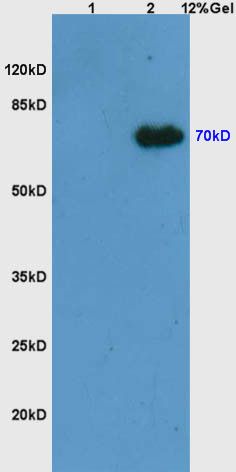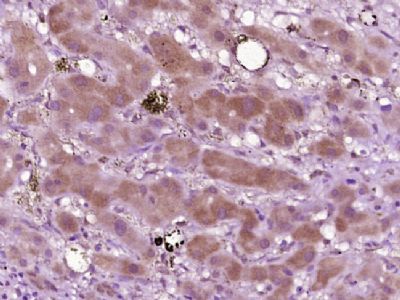产品中心
当前位置:首页>产品中心Anti-Phospho-Syk (Tyr525 + Tyr526)
货号: bs-3434R 基本售价: 1580.0 元 规格: 100ul
产品信息
- 产品编号
- bs-3434R
- 英文名称
- Phospho-Syk (Tyr525 + Tyr526)
- 中文名称
- 磷酸化非受体型酪氨酸蛋白激酶抗体
- 别 名
- Syk (phospho Y525); p-Syk (phospho Y525); Syk (Phospho Y525 + Y526); Syk (Phospho Tyr525 + Tyr526); KSYK_HUMAN; p72syk; Spleen tyrosine kinase; Syk; Tyrosine protein kinase SYK; Tyrosine-protein kinase SYK antibody; Tyrosine-protein kinase SYK (Spleen tyrosine kinase) [Contains: 72kDa tyrosine-protein kinase SYK; 40 kDa tyrosine-protein kinase SYK.
- 规格价格
- 100ul/1580元购买 大包装/询价
- 说 明 书
- 100ul
- 产品类型
- 磷酸化抗体
- 研究领域
- 肿瘤 细胞生物 免疫学 信号转导 细胞凋亡 转录调节因子 激酶和磷酸酶
- 抗体来源
- Rabbit
- 克隆类型
- Polyclonal
- 交叉反应
- Human, Mouse, Rat, Chicken, Dog, Pig, Cow, Rabbit, Guinea Pig,
- 产品应用
- WB=1:500-2000 ELISA=1:500-1000 IHC-P=1:400-800 IHC-F=1:400-800 IF=1:100-500 (石蜡切片需做抗原修复)
not yet tested in other applications.
optimal dilutions/concentrations should be determined by the end user.
- 分 子 量
- 72kDa
- 细胞定位
- 细胞浆 细胞膜
- 性 状
- Lyophilized or Liquid
- 浓 度
- 1mg/ml
- 免 疫 原
- KLH conjugated Synthesised phosphopeptide derived from human Syk around the phosphorylation site of Tyr525/526:EN(p-Y)(p-Y)KA
- 亚 型
- IgG
- 纯化方法
- affinity purified by Protein A
- 储 存 液
- 0.01M TBS(pH7.4) with 1% BSA, 0.03% Proclin300 and 50% Glycerol.
- 保存条件
- Store at -20 °C for one year. Avoid repeated freeze/thaw cycles. The lyophilized antibody is stable at room temperature for at least one month and for greater than a year when kept at -20°C. When reconstituted in sterile pH 7.4 0.01M PBS or diluent of antibody the antibody is stable for at least two weeks at 2-4 °C.
- PubMed
- PubMed
- 产品介绍
- background:
Syk (72 kDa) is a non receptor protein tyrosine kinase that plays an important role in immune receptor signal transduction and is implicated in endothelial cell functions, including cell growth and migration. SYK is a positive effector of BCR stimulated responses. It couples the B cell antigen receptor (BCR) to the mobilization of calcium ions either through a phosphoinositide 3 kinase dependent pathway, when not phosphorylated on tyrosines of the linker region, or through a phospholipase C gamma dependent pathway, when phosphorylated on Tyr 342 and Tyr 346. Thus the differential phosphorylation of SYK can determine the pathway by which BCR is coupled to the regulation of intracellular calcium ions. Alternate Names: p72syk; Spleen tyrosine kinase; Tyrosine protein kinase SYK.
Function:
Non-receptor tyrosine kinase which mediates signal transduction downstream of a variety of transmembrane receptors including classical immunoreceptors like the B-cell receptor (BCR). Regulates several biological processes including innate and adaptive immunity, cell adhesion, osteoclast maturation, platelet activation and vascular development. Assembles into signaling complexes with activated receptors at the plasma membrane via interaction between its SH2 domains and the receptor tyrosine-phosphorylated ITAM domains. The association with the receptor can also be indirect and mediated by adapter proteins containing ITAM or partial hemITAM domains. The phosphorylation of the ITAM domains is generally mediated by SRC subfamily kinases upon engagement of the receptor. More rarely signal transduction via SYK could be ITAM-independent. Direct downstream effectors phosphorylated by SYK include VAV1, PLCG1, PI-3-kinase, LCP2 and BLNK. Initially identified as essential in B-cell receptor (BCR) signaling, it is necessary for the maturation of B-cells most probably at the pro-B to pre-B transition. Activated upon BCR engagement, it phosphorylates and activates BLNK an adapter linking the activated BCR to downstream signaling adapters and effectors. It also phosphorylates and activates PLCG1 and the PKC signaling pathway. It also phosphorylates BTK and regulates its activity in B-cell antigen receptor (BCR)-coupled signaling. Beside its function downstream of BCR plays also a role in T-cell receptor signaling. Plays also a crucial role in the innate immune response to fungal, bacterial and viral pathogens. It is for instance activated by the membrane lectin CLEC7A. Upon stimulation by fungal proteins, CLEC7A together with SYK activates immune cells inducing the production of ROS. Also activates the inflammasome and NF-kappa-B-mediated transcription of chemokines and cytokines in presence of pathogens. Regulates neutrophil degranulation and phagocytosis through activation of the MAPK signaling cascade. Also mediates the activation of dendritic cells by cell necrosis stimuli. Also involved in mast cells activation. Also functions downstream of receptors mediating cell adhesion. Relays for instance, integrin-mediated neutrophils and macrophages activation and P-selectin receptor/SELPG-mediated recruitment of leukocytes to inflammatory loci. Plays also a role in non-immune processes. It is for instance involved in vascular development where it may regulate blood and lymphatic vascular separation. It is also required for osteoclast development and function. Functions in the activation of platelets by collagen, mediating PLCG2 phosphorylation and activation. May be coupled to the collagen receptor by the ITAM domain-containing FCER1G. Also activated by the membrane lectin CLEC1B that is required for activation of platelets by PDPN/podoplanin. Involved in platelet adhesion being activated by ITGB3 engaged by fibrinogen.
Subunit:
Interacts with LYN; phosphorylates SYK (By similarity). Interacts with RHOH (phosphorylated); regulates mast cells activation (By similarity). Interacts with NFAM1 (phosphorylated); probably involved in BCR signaling (By similarity). Interacts with VAV1 (via SH2 domain); phosphorylates VAV1 upon BCR activation. Interacts with GAB2 (phosphorylated); probably involved in IgE Fc receptor signaling (By similarity). Interacts (via its SH2 domains) with CD79A (via its phosphorylated ITAM domain); the interaction stimulates SYK autophosphorylation and activation (By similarity). Interacts with FCRL3. Interacts (via SH2 domains) with FCER1G (via ITAM domain); activates SYK and mediates neutrophils and macrophages integrin-mediated activation (By similarity). Interacts with ITGB2 and FGR; involved in ITGB2 downstream signaling (By similarity). Interacts with ITGB3; upon activation by ITGB3 promotes platelet adhesion. Interacts (via SH2 domains) with TYROBP (via ITAM domain); involved in neutrophils and macrophages integrin-mediated activation (By similarity). Interacts with MSN and SELPLG; mediates the selectin-dependent activation of SYK by SELPLG. Interacts with BLNK (via SH2 domain). Interacts (via the second SH2 domain) with USP25 (via C-terminus); phosphorylates USP25 and regulates USP25 intracellular levels. Interacts (via SH2 domains) with CLEC1B (dimer). Interacts with CLEC7A; participatex in leukocyte activation in presence of fungal pathogens. Interacts (phosphorylated) with SLA; may regulate SYK through CBL recruitment. Interacts with YWHAG; attenuates BCR-induced membrane translocation and activation of SYK. Interacts with Epstein-Barr virus LMP2A.
Subcellular Location:
Cell membrane (Probable). Cytoplasm, cytosol (Probable).
Tissue Specificity:
Widely expressed in hematopoietic cells (at protein level). Within the B-cells compartment it is for instance expressed for pro-B-cells to plasma cells.
Post-translational modifications:
Ubiquitinated by CBLB after BCR activation; which promotes proteasomal degradation (By similarity).
Autophosphorylated. Phosphorylated on tyrosine residues by LYN following receptors engagement. Phosphorylation on Tyr-323 creates a binding site for CBL, an adapter protein that serves as a negative regulator of BCR-stimulated calcium ion signaling. Phosphorylation at Tyr-348 creates a binding site for VAV1. Phosphorylation on Tyr-348 and Tyr-352 enhances the phosphorylation and activation of phospholipase C-gamma and the early phase of calcium ion mobilization via a phosphoinositide 3-kinase-independent pathway (By similarity). Phosphorylation on Ser-297 is very common, it peaks 5 minutes after BCR stimulation, and creates a binding site for YWHAG. Phosphorylation at Tyr-630 creates a binding site for BLNK. Dephosphorylated by PTPN6.
Similarity:
Belongs to the protein kinase superfamily. Tyr protein kinase family. SYK/ZAP-70 subfamily.
Contains 1 protein kinase domain.
Contains 2 SH2 domains.
SWISS:
P43405
Gene ID:
6850
Database links:Entrez Gene: 6850 Human
Entrez Gene: 20963 Mouse
Entrez Gene: 25155 Rat
Omim: 600085 Human
SwissProt: P43405 Human
SwissProt: P48025 Mouse
SwissProt: Q64725 Rat
Unigene: 371720 Human
Unigene: 375031 Mouse
Unigene: 87407 Rat
Important Note:
This product as supplied is intended for research use only, not for use in human, therapeutic or diagnostic applications.
非受体型酪氨激酶蛋白(TPK)介导的信号传递在T细胞,B细胞,NK细胞和粒细胞激活的过程中发挥着重要作用,其基因结构或基因表达的异常是某些免疫缺陷性疾病和免疫增殖性疾病的发生原因。
- 产品图片
 Sample:
Sample:
Lane1: Embryo (Mouse) Lysate at 30 ug
Lane2: Thymus (Mouse) Cell Lysate at 30 ug
Primary: Anti- phospho-Syk (Tyr525/526) (bs-3434R) at 1/300 dilution
Secondary: IRDye800CW Goat Anti-Rabbit IgG at 1/20000 dilution
Predicted band size : 72kD
Observed band size : 70kD Paraformaldehyde-fixed, paraffin embedded (human liver carcinoma); Antigen retrieval by boiling in sodium citrate buffer (pH6.0) for 15min; Block endogenous peroxidase by 3% hydrogen peroxide for 20 minutes; Blocking buffer (normal goat serum) at 37°C for 30min; Antibody incubation with (Syk (Tyr525 + Tyr526)) Polyclonal Antibody, Unconjugated (bs-3434R) at 1:400 overnight at 4°C, followed by operating according to SP Kit(Rabbit) (sp-0023) instructionsand DAB staining.
Paraformaldehyde-fixed, paraffin embedded (human liver carcinoma); Antigen retrieval by boiling in sodium citrate buffer (pH6.0) for 15min; Block endogenous peroxidase by 3% hydrogen peroxide for 20 minutes; Blocking buffer (normal goat serum) at 37°C for 30min; Antibody incubation with (Syk (Tyr525 + Tyr526)) Polyclonal Antibody, Unconjugated (bs-3434R) at 1:400 overnight at 4°C, followed by operating according to SP Kit(Rabbit) (sp-0023) instructionsand DAB staining.

